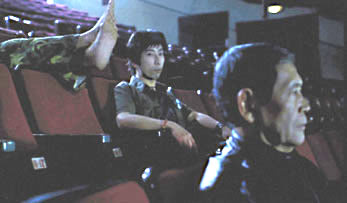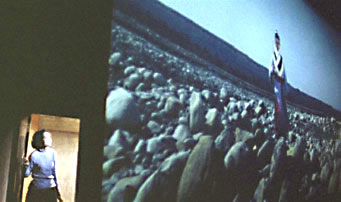JUMP CUT
A
REVIEW OF CONTEMPORARY MEDIA
![]()

At the beginning of Tsai’s film, we peek through curtains to watch Dragon Inn playing to a full house.


Barthes: “the inoccupation of bodies, which best defines modern eroticism” (346).


Framing the figure: the ticket woman (Chen Shiang-chyi) and the big screen.


The restroom “gag” in What Time Is It There?


A fantasy partner musical number in The Hole.


“There is no sexual relation.”


Queer bathhouse sex in The River.


When the father realizes he has just had anonymous sex with his son, he slaps the youth.


A James Dean poster points at Hsiao-kang (Lee Kang-sheng) in Rebels of the Neon God.


Antoine Doinel (Jean-Pierre Léaud) in the centrifuge scene in Truffaut’s 400 Blows.




Tsai’s short film The Skywalk Is Gone (a follow-up to What Time Is It There? included as a DVD extra with Goodbye, Dragon Inn).
![]()
Leaving the cinema:
metacinematic cruising
in Tsai Ming-liang’s
Goodbye, Dragon Inn
"Trick becomes the metaphor for many adventures which are not sexual; the encounter of a glance, a gaze, an idea, an image, ephemeral and forceful association, which consents to dissolve so lightly, a faithless benevolence: a way of not getting stuck in desire, though without evading it; all in all, a kind of wisdom."— Roland Barthes, Preface to Renaud Camus’s Tricks (1979) [Rustle 295]
In his evocative essay “Leaving the Movie Theater,” Roland Barthes proposes a particular way of going to the movies:
“by letting oneself be fascinated twice over, by the image and its surroundings — as if I had two bodies at the same time: a narcissistic body which gazes, lost, into the engulfing mirror, and a perverse body, ready to fetishize not the image but precisely what exceeds it: the texture of the sound, the hall, the darkness, the obscure mass of the other bodies” (Rustle 348).
This urban eroticism in the dark of the movie theater, the bodies sliding down in their seats as if in a bed (346), is crucial as a way to reinsert “queer” eroticism into movie-going. Barthes enjoys the anonymity and availability of the dark mass of the bodies in the movie house in opposition to the foreclosed eroticization of the place in the domestic well-lit scene of the television:
“television doomed us to the Family” (346).
That gay/queer [1] [open endnotes in new window] men in particular have made use of theaters for the purpose of cruising has a long history, which shows up in Midnight Cowboy (1969), Far From Heaven (2002), and in Samuel Delany’s Times Square Red, Times Square Blue. But Barthes’s works suggest that “cruising” might also be thought of as a more general type of experience: the reader’s relation to the text, which at the same time “cruises” him or her (Pleasure 4–6; 27). Tsai Ming-liang’s Goodbye, Dragon Inn (2003) connects both these aspects: the situation of the movie theater as a place of the anonymous multitude cruising each other in the dark, and the drifting relation of the spectator to the cinematic image. Tsai simultaneously provokes fascination and distance, which best captures Barthes’s sense that
“I am hypnotized by a distance; and this distance is not critical (intellectual); it is, one might say, an amorous distance” (Rustle 349).
Both Barthes and Tsai emphasize the place and spatial conditions of the cinema itself (the shadowy box, the “big screen”), but also temporality (both in the sense of “duration” and “history”). They ask: what does it mean to leave or say goodbye to “the cinema”? Barthes clarifies the pun:
“Whenever I hear the word cinema, I can’t help thinking hall, rather than film” (346).
Tsai’s film fits into the longstanding genre of “metacinema” (from Sunset Boulevard [1950] to Scream [1996]), but it also takes on a particular local significance: Tsai’s choice of King Hu’s 1966 Dragon Inn (a.k.a. Dragon Gate Inn) — as the final film screened at a movie theater which is closing its doors indefinitely — indexes the rise and fall of Taiwanese cinema, thereby invoking the industry’s history in a wistful manner. Such a description of the historic place of cinema can also be found in Barthes and Delany, but this is not simply nostalgia for a lost era, as Delany insists (xviii). Instead, it laments the loss of the social contact which movie houses fostered [2] — social contact which is cross-class and queer: thus feared by social conservatives. Like José Muñoz’s discussion of the “Ghosts of Public Sex,” I believe that rather than being simply hopelessly nostalgic, the present is haunted by the virtual potential of queer ways of occupying space, as in parks, public restrooms, arcades, and movie theaters.
Before directly engaging with Goodbye, Dragon Inn, however, I must first consider the problem of how to read Tsai’s work, foremost in relation to his entire oeuvre, since Tsai sees himself as an auteur; next in relation to critical debates about East-West aesthetic differences and influences; and lastly in relation to questions of modernism/ postmodernism and globalization.
Beyond the auteurist repetition of certain motifs — pouring rain, a notable lack of dialogue, the same Taipei locations and actors/roles — Tsai’s work is pervaded by the overall theme of urban alienation yet strangers' potential contact. Regarding The Hole (1998), Tsai has explained:
“I think it’s my observation of people also being so lonely, existing in their own solitude. It’s what I’ve observed about Taipei” (Walsh, online).
Some examples of Tsai's work include:
- What Time Is It There? (2001) — which features the same movie theater used in Goodbye, Dragon Inn, and a hilarious gag about bathroom sex, and is explicit about heterosexual, gay, and lesbian cruising in Taipei and Paris;
- Vive L’Amour (1994) — a film about real estate, cruising, and a kind of “sexual disorientation”;
- The Hole — which seems to demonstrate Lacan’s assertion that “there is no sexual relation” [3];
- The River (1997) — his most explicit treatment of another anonymous liminal queer erotic space: the bathhouse, and the possibility of accidental incest therein); and
- Rebels of the Neon God (1992).
Lee Kang-sheng (“Hsiao-kang”) seems to be almost a “muse” within Tsai’s oeuvre, [4] representing a version of the sexually ambiguous “rebel without a cause” icon James Dean (who appears in poster-form in Rebels of the Neon God, another metacinematic gesture).
These themes are in some ways a continuation of the concerns of the “New” Taiwan and Hong Kong cinemas, as Nick Browne has characterized them:
"The contemporary, one might almost say “modernist,” mode of Taiwan and Hong Kong cinemas adapts the art film format to the underlying and fundamental cultural trope of the period [the 1980s]—cultural and psychological dislocation … In Taiwan cinema … its central emblem is the aleatory form of metropolitan simultaneity and contingency … [A]s Fredric Jameson argues in “Remapping Taipei,” Terrorizer [Yang, 1986] adopts a European form—a sustained formal reflexivity … [which] gives us a kind of modernist picture of total dissolution of the traditional social and ethical complex." (6–7)
Regardless of whether this traditional social and ethical complex is “mourned” in Tsai’s works (a case could be made either way), Browne’s emphasis on the emblematic metropolis is crucial for thinking about Tsai’s films. Jameson goes into more detail regarding what he calls the “providential” plot of interwoven character destinies, or “the narrative of synchronous monadic simultaneity (henceforth, SMS)” which he finds essentially modernist. However, he notes that
"The return, therefore of what looks like a Western modernist narrative paradigm (the SMS) in the work of a Third World filmmaker (in the thick of postmodernity as a global tendency, if not a global cultural and social reality) can be expected to raise new questions, which do not include the relatively idle one, debated by critics and journalists at the film’s first showing in its native Taiwan, as to whether the director had sold out to essentially Westernizing methods or style" (119).
Like Yang’s, it could be debated whether Tsai’s work should be seen as “Westernized”—a label Rey Chow has interrogated for all its ambivalence in relation to Chinese films which receive Western accolades, such as Zhang Yimou’s or Tsai’s (155–56). Certainly, What Time Is It There? stands in dialogue with the history of the French nouvelle vague, with its metacinematic incorporation of Truffaut’s The 400 Blows (1959). But Fran Martin has argued that this retrospective transcultural citation needs a more complicated explanation than Eurocentric notions of “influence.” She says that “an adequate understanding of Tsai’s cinema cannot be gained from simply observing stylistic resemblances between Tsai’s style and those of particular European directors” but rather that we need to look
“to the historical and cultural specificities of the local context of these films’ production, conditions that determine, to a great degree, the cultural meanings of the films’ emphatic European citations” (online).
Brian Hu has also noted a shift in Tsai’s work starting with The Hole, and discusses Tsai’s short film The Skywalk is Gone (2002) in terms of Taiwanese and Chinese rather than Western cinema traditions (online). Hu argues that Tsai’s films reflect nostalgia for Chinese and Taiwanese cinema history, and for the constantly transforming city of Taipei. I will return to the question of nostalgia later, but would like to consider the role of the city itself first.
To
top![]() Print
version
Print
version![]() JC 50
JC 50 ![]() Jump
Cut home
Jump
Cut home

This work is licensed under a Creative Commons Attribution-NonCommercial-NoDerivs 2.5 License.